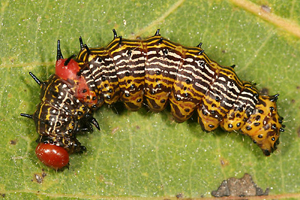Leaf Feeders
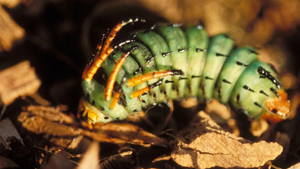
Daniel Herms, The Ohio State University, Bugwood.org
Hickory horned devils are impressive pea green to blue green caterpillars that are 4 to 5 inches long when full grown. They have two pairs of yellow to orange curved horns just behind the head and paired rows of spines down the back. These caterpillars will lash around when disturbed but are not dangerous. HHD are present from July to September. They spend the winter as pupae in the soil. These caterpillars eat a lot of leaf tissue but only pose a threat to small trees. They are rarely numerous enough to defoliate medium to large trees. HHD can feed on butternut, ash, sweet gum, and persimmon. For more information, see Entfact 008.
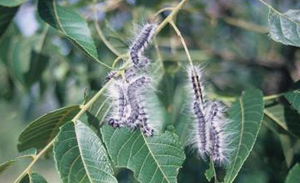
Ward Upham, Kansas State University, Bugwood.org
Walnut caterpillars are black and covered with long gray to white hairs. Clusters of eggs are laid on leaves in June so there can be groups of caterpillars on a tree. They feed mainly during June and July and can defoliate small to medium-sized trees. Two or more years of heavy foliage loss can severely stress or kill trees. Mature larvae drop to the ground and wander in search of a place to pupate and transform to the adult or moth stage. There can be two generations during a season. These insects will feed on butternut, hickory, and pecan.
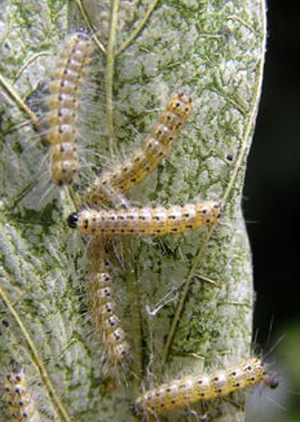
Milan Zubrik, Forest Research Institute - Slovakia, Bugwood.org
Fall webworms are small, hairy white caterpillars that live communally in thin silken webs at the ends of branches. They may leave the tent to feed individually as they get larger. While the webbing is unsightly, feeding damage is usually limited to limbs around the tent. Large established trees are not seriously affected by small to moderate infestations. The larval stage feeds for 4 to 8 weeks and may be found on a variety of hardwoods. The first generation occurs in late May and early June, the second generation is usually larger and active from July through September. For more information, see Entfact 424.
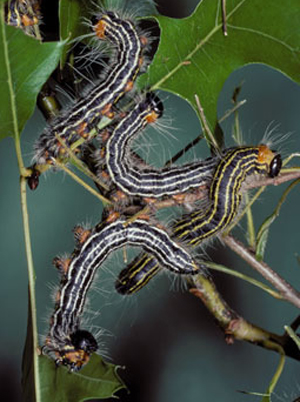
Gerald J. Lenhard, Louisiana State University, Bugwood.org
Yellownecked caterpillars are black caterpillars with thin longitudinal yellow stripes and some fine white hairs. The head is black and a plate just behind the head is yellow-orange. Eggs are laid in clusters of about 100 so there may be many individuals on a single tree. YNC caterpillars feed for about 4 weeks and tend to remain together. Mature larvae are about 2 inches long. Most of the damage is done in August and September. These caterpillars also feed on oak and other hardwoods. YNC overwinters in the soil as pupae.
At its largest, the Redhumped caterpillar is 1-1.5 inches long. The head and first abdominal segment are red, the rest of the body is yellow with black and white stripes. Black tubercles extend from the back. These caterpillars initially feed as a group on a single leaf, skeletonizing it, and use a collective warning display to ward off predators. As they grow, they will spread out as individuals and consume entire leaves. Mature larvae overwinter in the soil and pupate in the spring. Adults fly from June till July and caterpillars feed July to September.
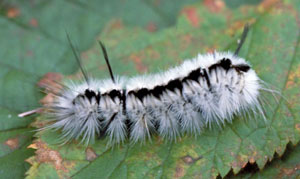
John Ghent, John Ghent, Bugwood.org
The caterpillar stage of the Hickory tussock moth feeds from July to September. Similar to other tussock moths, the hickory tussock has a hairy appearance and is black and white in color. They begin by feeding in groups before moving apart to find leaves. This caterpillar does pose a "stinging" hazard as contact with the hairs may induce a rash on susceptible people.
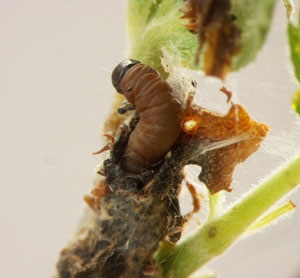
Copyright © 2018 John van der Linden, bugguide.net, used with permission
The Leaf crumpler larva is around an inch long, with a green-grey color with purple markings at each segment. The adult is a small moth with brown and white stripes along its wings. The caterpillars build web tubes on twigs which incorporate leaf fragments as they feed. The tube can be 1.5-2 inches long by the time the caterpillar is mature. Damage and nests are at their peak in July and August.
Sap Feeders
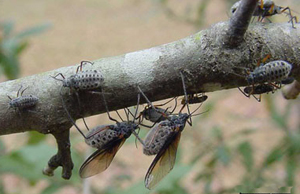
Herbert A. 'Joe' Pase III, Texas A&M Forest Service, Bugwood.org
Giant bark aphid is the largest aphid in North America. This sap feeder can live on several tree species. Winged forms disperse from tree to tree. Wingless aphids occur in large colonies. These aphids produce a large amount of sticky liquid waste, honeydew, which drips onto objects below. Feeding by large numbers of these aphids can damage or kill small twigs. They are eaten by lady beetles and other predators.
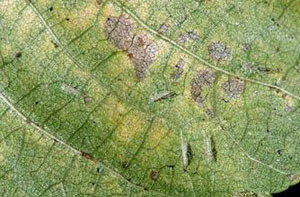
Whitney Cranshaw, Colorado State University, Bugwood.org
Leafhoppers are small, active insects that live on the underside of the leaves. They use sucking mouthparts to feed on plant sap. Usually large numbers are present by the time the injury is obvious. Heavily damaged leaves may drop early but this insect usually does not cause serious problems.
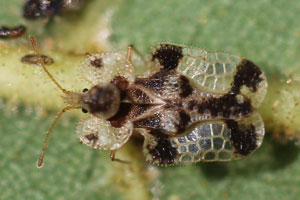
Whitney Cranshaw, Colorado State University, Bugwood.org
Walnut lace bugs feed on black walnut trees by sucking sap from leaves. They typically feed on the undersides of leaves and cause discoloration. Leaves will have yellow stippling and lace bug frass resembles droplets of motor oil. They feed throughout the summer and damage is most noticeable by autumn. They are 1/8 to 1/3 inch long and their wings and thorax have a lacy, doily-like appearance.
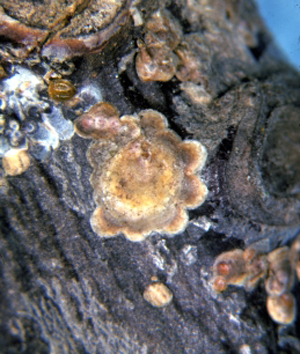
Raymond Gill, California Department of Food and Agriculture, Bugwood.org
Walnut scales are 1/8 inch long nearly circular, flat scales that are gray with a reddish brown spot. Crawlers are active in mid June and in late August to early September in Kentucky. For more information, see Entfact 436.
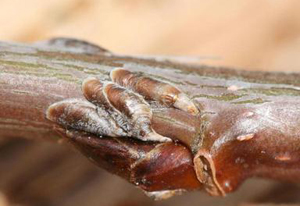
Whitney Cranshaw, Colorado State University, Bugwood.org
Oystershell scales are about 1/10 inch long and resemble crusty accumulations of oyster shells on the bark. Their drab, bark-like appearance makes them easy to overlook, even on close inspection. Heavy infestations can kill twigs or branches. This scale overwinters in the egg stage under the waxy covering of the female. The eggs hatch and the crawlers are active from late May to early June.
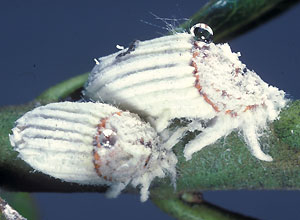
Sturgis McKeever, Georgia Southern University, Bugwood.org
Cottony cushion scale is an invasive scale species that can be found feeding on the sap of numerous species of plants. Adult females are orange-brown but coated with white wax and will have a long, fluted egg sac attached to the body. This can contain up to 1,000 eggs. After hatching, the nymphs (which are red with dark antennae and legs) will seek a suitable space for feeding. Nymphal feeding on leaves can cause extensive damage and honeydew/black sooty mold will accumulate as the population builds.
Borers
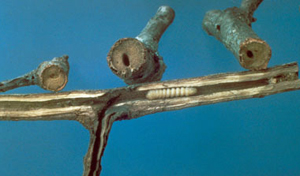
James Solomon, USDA Forest Service, Bugwood.org
Twig pruners are the larvae of small beetles that tunnel in twigs and small branches. Female beetles lay their eggs about the time of bud break in the spring. Eggs are laid in small holes which are chewed into the bark. The larvae that hatch from these eggs bore into and tunnel toward the base of twigs. In late summer, they chew concentric circles outward toward the bark then move toward the tip. The twig eventually snaps and falls to the ground. The larva pupates in the fallen twig and emerges as an adult in the spring. Collecting and destroying fallen twigs can help to reduce infestations.
